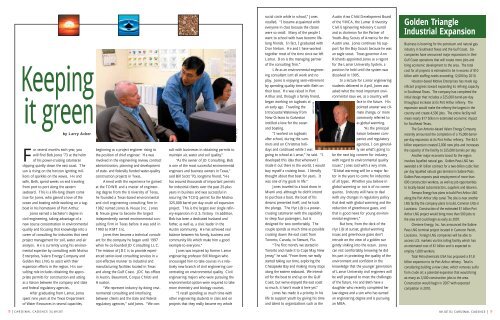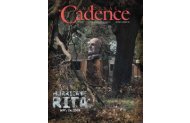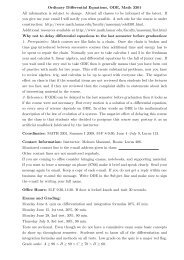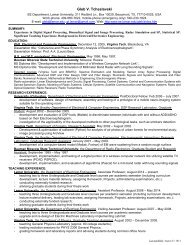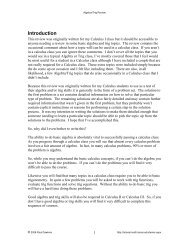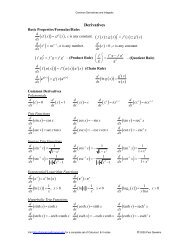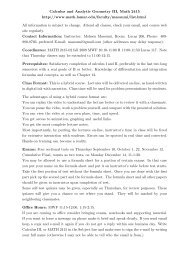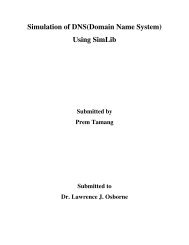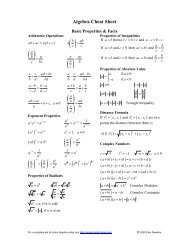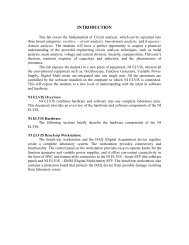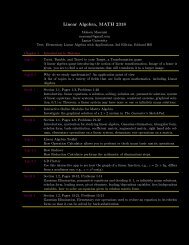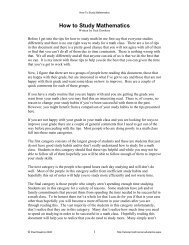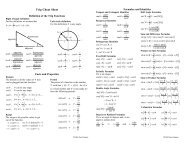A cultural affinity - Lamar University
A cultural affinity - Lamar University
A cultural affinity - Lamar University
Create successful ePaper yourself
Turn your PDF publications into a flip-book with our unique Google optimized e-Paper software.
COURTESY OF NASA<br />
on campus on campus<br />
Making class count<br />
Hybrid earns engineering majors first place . . .<br />
Mechanical engineering juniors Greg Muller, Hong<br />
Vo, Terry Smith and Dustan Sapp, competed in the<br />
Shell Eco-Marathon in Fontana, Calif., April 12-15<br />
and received first place in the hybrid division. The<br />
principle of the marathon is to design and build a<br />
car that releases the fewest emissions, and the purpose<br />
of the competition is to encourage students to<br />
create possible energy solutions. The LU Racer, a<br />
soapbox-car-sized vehicle with a frame of metal tubing<br />
and bicycle tires, ran on a 48cc motorcycle<br />
engine and an electric motor from a Schwinn scooter.<br />
After the hybrid racer was complete, the team<br />
drove 26 hours from Beaumont to California with<br />
the racer in tow. Unfortunately, in Arizona, a sand<br />
storm caused the tarp covering the racer to chafe<br />
the car down to the metallic skin. The team had to<br />
re-skin the car the day before the race, but that didn’t<br />
prevent the win. The team received first place in<br />
the hybrid division with 298.2 miles per gallon.<br />
According to Shell’s website, the team has established<br />
a legacy by showing generosity in the garage.<br />
<strong>Lamar</strong>’s team donated sheet metal to Louisiana<br />
State <strong>University</strong> and modified their gears, did welding<br />
for the team from Ontario, and gave technical<br />
advice to high school students from the Los Altos<br />
Academy of Engineering • <strong>Lamar</strong> in select group of<br />
two . . . A<br />
seven-student<br />
team traveled to<br />
NASA Johnson<br />
Space Center’s<br />
Ellington Field<br />
in Houston to<br />
conduct lunar gravity experiments aboard the<br />
“Weightless Wonder” aircraft. <strong>Lamar</strong>’s team was<br />
among 34 college and university teams from around<br />
the nation selected to fly this year, but was one of<br />
only two schools chosen to conduct lunar gravity<br />
experiments. Team members are Jonathan Sterling, a<br />
senior mechanical engineering major from Orange;<br />
Bachelor’s<br />
degrees<br />
now online<br />
Southeast Texans interested in<br />
beginning or completing their<br />
bachelor’s degree may<br />
now pursue that goal<br />
from the convenience<br />
of home, earning credit<br />
for what they<br />
already know. Up<br />
to 24 hours of<br />
experiential learning may apply<br />
toward completion of the bachelor of<br />
applied arts and sciences (B.A.A.S.). <strong>Lamar</strong>’s<br />
online bachelor of general studies (B.G.S.) program is an ideal way to complete a<br />
four-year degree with the freedom to choose multiple areas of interest.<br />
These two online programs provide flexible options for people who have<br />
already invested in coursework leading to a two-year degree or who have been in<br />
the work force and would like to advance. Online (web-based) courses are completed<br />
from home, office or on campus. That convenience means students can earn a<br />
degree without leaving their communities or their jobs. “<strong>Lamar</strong> <strong>University</strong> offers a<br />
wide array of courses in several disciplines that are now available online,” said Paula<br />
Nichols, director for the Center for Distance Education. “These courses are flexible,<br />
affordable and fully accredited toward the students’ degree plans.”<br />
Students interested in online courses will have a special orientation prior to the<br />
start of the semester. Students must be able to access the Internet and are encouraged<br />
to have a broadband connection. Full technical support via e-mail, telephone<br />
and the Web is available as well (lamar.edu/luonline).<br />
The opportunity to experiment with some high-tech gear comes with the donation of a Garrett<br />
Electronics PD6500i walk-through metal detector and handheld detector from Charles Garrett, a<br />
1959 <strong>Lamar</strong> graduate in electrical engineering. <strong>Lamar</strong> electrical engineering majors Jessica<br />
Hammerly, Nelson Gaspard and Greg Gattis assembled the unit in the Cherry Engineering Building.<br />
BRIAN SATTLER<br />
<strong>Lamar</strong> <strong>University</strong> offers Chinese<br />
language, culture courses<br />
This fall, the unique sounds of spoken<br />
Chinese will fill classrooms as students<br />
tackle one of the world’s more challenging—and<br />
populous—languages.<br />
<strong>Lamar</strong> <strong>University</strong> will begin classes in<br />
Standard Mandarin in<br />
the Spring.<br />
Initially, the university<br />
will offer two fivecredit-hour<br />
courses. The<br />
classes will meet Monday through<br />
Friday for one hour each day.<br />
Standard Mandarin — also known<br />
as Standard Chinese, Standard<br />
Mandarin Chinese or Standard spoken<br />
Chinese — is the official, modern<br />
Chinese spoken language used by the<br />
People’s Republic of China, the<br />
Republic of China (Taiwan) and<br />
Singapore and is spoken by more than a<br />
billion people worldwide.<br />
The courses, offered as CHIN<br />
1511 Beginning Chinese I and CHIN<br />
1512 Beginning Chinese II, will not<br />
only present the spoken language, but<br />
also introduce students to the written<br />
language, customs and culture of China.<br />
The first course will introduce students<br />
who have no background in the<br />
language to its characters, tones and<br />
cadences through listening, speaking,<br />
reading and writing in Chinese and<br />
will improve their <strong>cultural</strong> knowledge<br />
as related to the language.<br />
Students completing the first<br />
course should be able to distinguish<br />
Chinese syllables and tones and understand<br />
short conversation with a vocabulary<br />
of more than 600 words.<br />
Students will be able to carry on conversations<br />
on essential topics and read<br />
simple texts. After completing the<br />
course, students should be able to<br />
write from memory approximately 350<br />
Chinese characters in simplified form.<br />
The second course is designed to<br />
develop the students’ ability to communicate<br />
in Chinese to fulfill real-life<br />
tasks and to build on their listening,<br />
speaking, reading and writing skills. In<br />
the course, students will learn a greater<br />
variety of Chinese expression and further<br />
explore the culture and customs of<br />
Chinese-speaking people.<br />
At the end of this course, students<br />
should be able to understand<br />
conversations with a<br />
vocabulary of more than<br />
1,200 words. Students<br />
will be able to comprehend<br />
200 key sentence patterns, and<br />
gain the ability to write more an 350<br />
additional Chinese characters in simplified<br />
form.<br />
The College of Arts and Sciences<br />
advisory board first suggested adding<br />
Chinese-language courses. The group<br />
has also recommended adding courses<br />
in Arabic and Russian, said Brenda<br />
Nichols, dean of the college.<br />
“The advisory board said to make<br />
offering Chinese the top priority,”<br />
Nichols said. “Certainly, the rise of<br />
China economically means knowing<br />
the language will create opportunities<br />
for our students.”<br />
The classes will also be available to<br />
the community on a non-credit basis.<br />
“This may open doors for people who<br />
recognize how these skills can open<br />
doors for them in business and more,”<br />
Nichols said. “There are a great many<br />
businesses in Southeast Texas that do<br />
business internationally.”<br />
The courses are a great opportunity<br />
for students who seek a unique challenge,<br />
Nichols said. Adding a foreign<br />
language to a degree program can<br />
enhance a graduate’s value to future<br />
employers. The university’s<br />
Department of English and Modern<br />
Languages offers bachelor’s degrees,<br />
minors and teaching certificates in<br />
French and Spanish and a minor in<br />
German.<br />
Soon, a number of <strong>Lamar</strong><br />
<strong>University</strong> students will be able to add<br />
themselves to the millions who speak<br />
Chinese as they gain a handle on the<br />
mysteries of Mandarin.<br />
Making class count, continued<br />
Jared Mills, junior, general business, Beaumont;<br />
Jonah Cherry, senior, mechanical engineering, Buna;<br />
and Tiffany Smith, senior, mechanical engineering,<br />
Mauriceville. Ground crew for the team were Linsey<br />
Lewis, a senior education major from Orange;<br />
Chase Williams, sophomore, electrical engineering<br />
and physics, Lumberton; and Micki Carpenter, senior,<br />
Beaumont. While in periods of lunar gravity, the<br />
students dropped a low-impact sphere into lunar<br />
soil simulant to study the effects on the dust in a<br />
vacuum chamber they built. Video recordings will<br />
enable the students to study the results frame by<br />
frame and present a final report of their findings to<br />
NASA • Comm students document disappearance .<br />
. . The JASON 2007 two-week, live event,<br />
“Disappearing Texas Wetlands,” kicked off Jan. 22<br />
with the arrival of the first 1,000 Southeast Texas<br />
fifth– through eighth– grade students. About 8,500<br />
students from 21 school districts and private schools<br />
viewed the “Disappearing Texas Wetlands” video,<br />
and participated in live activities involving local scientific<br />
and educational agencies whose mission is to<br />
protect Texas’ wetlands. This was the sixth year for<br />
<strong>Lamar</strong> <strong>University</strong> to host the annual JASON event,<br />
but this year was unique because <strong>Lamar</strong> communication<br />
students partnered with middle school and<br />
high school student “explorers” from school districts<br />
across Southeast Texas to film the video locally in<br />
six Southeast Texas wetland locations • Chemistry<br />
graduate student earns double . . . Rachel Bond, president-elect<br />
of the <strong>Lamar</strong> <strong>University</strong> Chapter of the<br />
Society of Plastics Engineers (SPE) was recently<br />
awarded second prize in the student poster competition<br />
at the International Polyolefins Conference.<br />
Her work, entitled “Effect of Substrate Interactions<br />
on the Melting of Thin Polyethylene Films” was<br />
conducted under the supervision of Paul Bernazzani,<br />
assistant professor of chemistry. Bond also was one<br />
of only two students awarded a $1,000 scholarship<br />
by the south Texas section of the SPE.<br />
10 | CARDINAL CADENCE 35:2 MAY 2007 MAY 2007 35:2 CARDINAL CADENCE | 11<br />
BRIAN SATTLER


